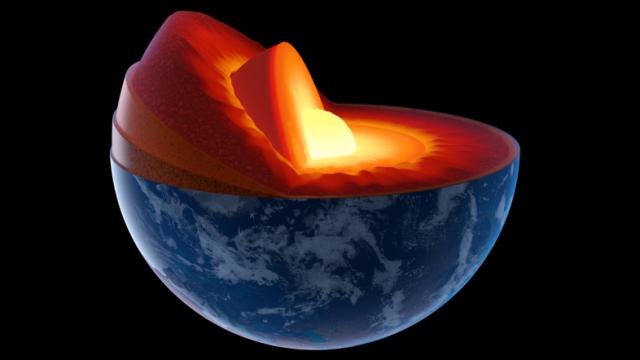When most of us imagine what the mantle of the Earth is like, we see burning hot rock and magma (and maybe satan hanging out for good measure). But scientists have discovered evidence that all that rock may be hiding huge amounts of water — three times the volume of all our oceans combined.
The scientists behind the study, which was published online today in the journal Science, think they have figured out the answer to a question that has long plagued Earth science: Just how much water is there on Earth in total? “I think we are finally seeing evidence for a whole-Earth water cycle, which may help explain the vast amount of liquid water on the surface of our habitable planet,” said study co-author and Northwestern geophysicist Steve Jacobsen to PhysOrg. “Scientists have been looking for this missing deep water for decades.”
The study is the first direct evidence of an idea that’s been bouncing around for years: That deep inside the Earth’s mantle — the layer below the crust and above the outer molten core — is hidden massive amounts of water in the rock. Specifically, the water is trapped inside a type of rock called ringwoodite, since it’s under tremendous pressure, and it plays a critical role in turning all that rock into magma. More on that later.
But first things first: How did Jacobsen and his co-author, University of New Mexico seismologist Brandon Schmandt — two scientists who live up here on the crust — figure out what’s going on 640km inside the Earth? In essence, they echo sounded it. Using a network of 2000 seismometers placed across the entire US, they were able to “listen” to the speed of the waves made by earthquakes as they moved through the varying depths of the Earth’s crust. Because water and rock react differently to those waves, they could figure out when the waves were hitting a watery patch versus a solid rock patch.
They didn’t stop there: They also simulated the pressure of being 640km below the Earth’s surface in a lab, so they could test how rock and water would react. And they found that ringwoodite (seen below) is a little bit like a sponge at those high pressures: it soaks up water at the molecular level so that as much as one per cent of its structure is water. In fact, all that water is the key to turning rock into magma.

So, would we ever be able to extract these resources? Almost certainly not — you can just imagine what would come of trying to tamper with the Earth’s mantle. Just discovering them is an amazing thing. And as PhysOrg explains, it’s not exactly as though these are literal oceans:
This fourth form is water trapped inside the molecular structure of the minerals in the mantle rock. The weight of 250 miles (402km) of solid rock creates such high pressure, along with temperatures above 2000 degrees Fahrenheit (1093C), that a water molecule splits to form a hydroxyl radical (OH), which can be bound into a mineral’s crystal structure.
It’s still an incredible discovery though. And it comes on the heels of a March study about a rare diamond that confirmed the existence of water trapped deep below the Earth’s crust. Now, thanks to the team behind this new paper, we know that a whole lot of it is sitting right below our feet. [Science, New Scientist, PhysOrg]
Picture: Johan Swanepoel
